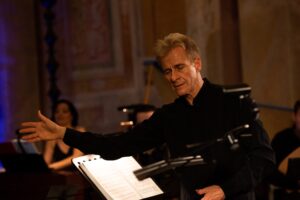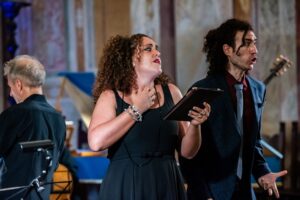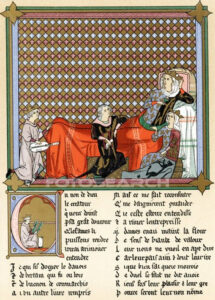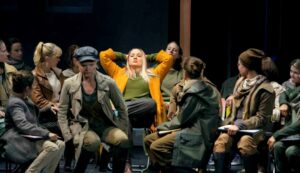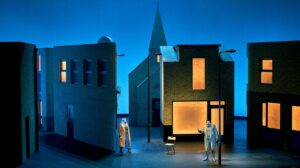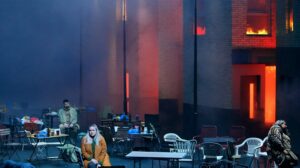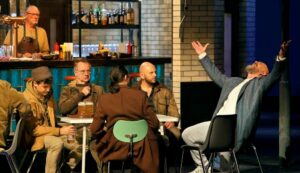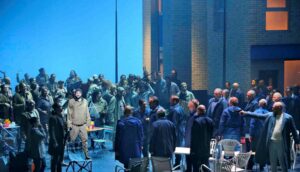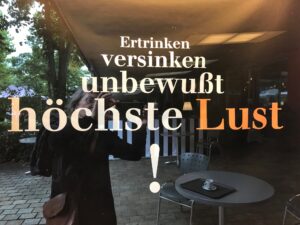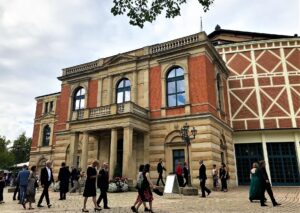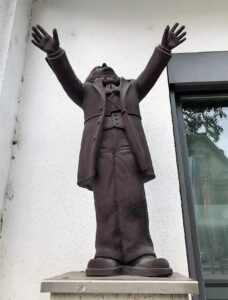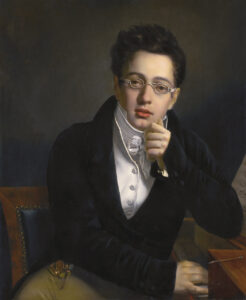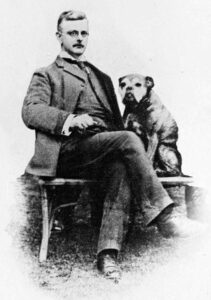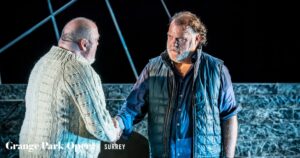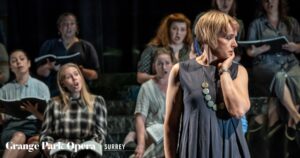Three Billboards Outside Caprarola, Viterbo
Do you remember Three Billboards Outside Ebbing, Missouri? Or, more precisely, the music Mildred Mayes is listening to in the car at the very beginning of the film? Most movie buffs were led to believe that they were dealing with a contemporary arrangement of a traditional Irish melody, while in fact Renée Fleming sings Lady Harriet’s aria “Letzte Rose” from Friedrich von Flotow’s opera Martha, though with Thomas Moore’s original text, taken from the 1813 collection Irish Melodies. The composer indeed referred to a popular song of the day, but transformed it in his own way and made it the basis not only of the aria, but also of the love theme that runs through the piece. Martha, staged in 1847 in Vienna, turned out to be Flotow’s second and last operatic success. Known to music lovers today for several immortal hits, it completely overshadowed his previous work: the opera Alessandro Stradella, the triumph of which at the Hamburg Opera subsequently led to a contract to stage Martha at Vienna’s Theater am Kärntnertor.
Flotow was neither the first nor the last among 19th-century composers who decided to make one of the most influential yet most mysterious composers of the Italian Baroque the protagonist of their operas. However, they were not interested in his music, but in his sensational biography, described in, for example, Histoire de la musique et de ses effets, the first compendium of the history of music in French literature, written by Pierre Bourdelot, a libertine, freethinker and physician to Louis XIII, later supplemented by his nephew Pierre Bonnet-Bourdelot and published only after the death of both by another heir of the family in 1715. The ambiguities of Stradella’s biography – which gradually expanded to include tales of his difficult character, propensity for scheming and gambling, and promiscuity, which ultimately brought upon him the revenge of his cuckolded rivals and death at the hands of assassins – became ideal fodder for Romantic librettists. However, instead of perpetrating a black legend of him, like the one surrounding the tragic figure of Caravaggio, the librettists came up with more and more complicated cloak-and-dagger stories, with the amorous Stradella successfully throwing a spanner in the works of torturers and guardians of female virtue, stories with an obligatory happy ending. This Stradella-mania even affected the teenage César Franck, who in 1841 – four years after the failure of Louis Niedermeyer’s five-act grand opéra at the Salle Le Peletier in Paris – composed his own Stradella, but stopped at the voices with piano stage and left the work unfinished.
Interest in Stradella waned at the turn of the 20th century, only to be revived in recent decades, thanks in part to new research which has finally made it possible to look at his life and work in a broader historical and aesthetic context. We know now that he was not born in 1639 in Nepi, but four years later in Bologna, though the most formative period of his life was his childhood and youth spent in Rome, where he received his musical education. We know that his innate independence combined with immense talent and extraordinary ambition got him into trouble more than once, and it is difficult to say whether his tragic death at the hands of Genoese thugs – when he was not yet forty – had more to do with his propensity for reckless love affairs or his inability to navigate the labyrinth of political and moral intrigues of the day. Stradella left behind a huge and immensely valuable body of work, rivalling the legacy of Purcell and Biber in originality, and going far beyond the stylistic framework of the period in innovation and imagination. He was a precursor of the concerto grosso. In experimenting with a more tuneful, rhythmically freer variety of counterpoint, full of dissonant tensions, he was more than ten years ahead of Corelli. He came up with the idea of the da capo aria before he had time to give it a proper form.
There is something spectral in Stradella’s oeuvre. It is possible to hear in it things that are not physically there yet, that were only geminating in the composer’s visionary imagination. This is probably why it is so admired by Salvatore Sciarrino, a contemporary master of musical understatements, thinned out consonances, of silence louder than sounds. In 2017 Sciarrino wrote an opera, Ti vedo, ti sento, mi perdo (I see you, I hear you, I lose myself), whose protagonist is Stradella – or rather his absence. The action takes place in 1682, in one of the Roman palazzi, where rehearsals take place before a performance of Stradella’s cantata. Everybody is waiting for a new aria promised by the composer, but instead they get the news of his sudden death. The truth about the composer, who became a legend during his lifetime, must from now on be sought in in-depth reflection on his music.
Andrea De Carlo. Photo: Famiano Crispi & Vincenzo Scudieri
The man at the forefront of this reflection is Andrea De Carlo, one of the world’s most eminent specialists in the legacy of Alessandro Stradella, an artist well known also to Polish music lovers from his collaboration with Rinaldo Alessandrini’s Concerto Italiano ensemble, not to mention the student production of Stradella’s comic opera Il Trespolo tutore (2018), which featured Polish musicians and was recorded on DVD. De Carlo began his career as a jazz double bass player, later joined in the orchestra of the Teatro Massimo di Palermo and eventually – after studying with the gambist Paolo Pandolfo – devoted himself almost entirely to the practice and theory of historical performance. In 2005 he founded his own ensemble, Mare Nostrum, which has evolved from a homogeneous viol consort into an extremely versatile and dynamic early music ensemble. Following their first, critically acclaimed concerts and recordings of German and French Baroque music, De Carlo and his musicians began to focus increasingly on the works of 17th-century composers associated with Rome. This naturally led to “The Stradella Project” – initiated as part of the Baroque Festival in Viterbo, headed by De Carlo – which has already resulted in eight excellent albums of monographic recordings for the French label Arcana. Young talent and future collaborators of De Carlo are forged in the “Stradella Young Project”, an education and research initiative launched in 2011, whose apprentices regularly participate in De Carlo’s projects.
This year I had the pleasure of accepting an invitation from the event organisers and the Munich-based agency Ophelias Culture to attend the first days of Festival Barocco Alessandro Stradella. And thus I was able not only enjoy the music, but also to relish the beauty of the historic region of Tuscia, the cradle of Etruscan civilisation, a land stretching among the hills between the Tiber and the Apennine range, in a territory that overlaps not only with today’s province of Viterbo in the northernmost part of Lazio, but also with the whole area of Tuscany and a large swathe of Umbria. Viterbo, one of the best-preserved medieval cities in central Italy – with its imposing Cathedral of Saint Lawrence, supposedly built on the ruins of an Etruscan temple of Heracles, and the mighty Palazzo dei Papi, where from November 1268 to September 1271 the cardinals were held on bread and water during the longest conclave in the history of the Church, before the election of Pope Gregory X – was preparing for the Macchina di Santa Rosa procession.
The march with the relics of St. Rose, a Franciscan tertiary expelled from the city by the Cathars, takes place year after year on the night of 3 September, along a route of more than a kilometre from Porta Romana to the steep climb to the church of Viterbo’s patron saint. One hundred men from the Sodality of the Porters (Facchini di Santa Rosa) carry a nearly 30-metre high tower, weighing five tons, through the streets, literally in the dark, following only the directions of the capofacchini, who march at the four corners of the enormous machine. In the days leading up to the procession residents are busy building stands in the traditional stopping places of the porters, and members of the Sodality proudly display its banners in the windows of their homes, in shop windows, restaurants and craftsmen’s workshops. Admission to the porters community is considered an exceptional honour in the local community – not least because, as part of the test, each candidate must lift a 150-kg box on his shoulders and carry it at least a hundred metres.
In these circumstances it is not surprising that the first concerts of the Festival took place outside the province’s capital. Yet it would be hard to imagine a better venue for the inauguration, with an opera by Stradella, than the Mannerist Villa Farnese, a gem of the late Italian Renaissance, towering over the town of Caprarola, which clings to the volcanic Cimini Hills. The young Cardinal Alessandro Farnese, only thirty-something at the time, acquired the estate at the very beginning of the 16th century. Educated by Pomponius Laetus to love classical proportions, he decided to erect a defensive palace above the settlement and commissioned the best architects active in Rome at the time to prepare the designs. The architects included Baldassare Peruzzi, who drew out the shape of the future fortress on a pentagonal plan. The construction of the foundations was completed only a few years before the cardinal was elected pope, who went down in history as Paul III. The work on the fortress was understandably put on hold. Nearly thirty years later it was resumed by the pope’s namesake and grandson, Alessandro Farnese: a cardinal, diplomat and generous patron of artists, who replaced the idea of completing the palazzo di fortezza with the idea of erecting a grand country villa on its foundations. The arduous mission of incorporating the body of the palace into the pentagon of the fortifications was undertaken by Jacopo Barozzi da Vignola, one of the most eminent architects of the second half of the 16th century, not only in Italy.
The result was a building of uncommon beauty, in the form of a pentagonal prism, but with a regular four-storey façade and a circular arcaded courtyard inside. Each storey of the villa served a different purpose and was furnished accordingly. Visitors are dazzled by the Sala dei Fasti Farnesiani on the piano nobile level. It is richly decorated with frescoes by the Zuccari brothers depicting the greatest achievements of the Farnese family. Taddeo Zuccari and his assistants are also the authors of the allegorical paintings in the Jupiter Room, accessible from the courtyard, which served as a sort of reception room for guests and a vestibule to the summer apartments. To enter it, visitors must first take their eyes off the illusion of foliage rustling in the wind, birds’ wings flapping and glimpses of sunlight on the azure of the frescoes on the arcade vaults.
Moro per amore, Villa Farnese, Caprarola. Eleonora Filipponi (Lindora) and Danilo Pastore (Floridoro/Feraspe). Photo: Famiano Crispi & Vincenzo Scudieri
This was the venue of the Festival’s inaugural performance – of Moro per amore, Stradella’s last opera, completed in 1681, a few months before his death. A similar villa, castello or palazzo may have been the venue for the first rehearsals before the work was staged at some theatre in Rome or Genoa. Similar frescoes may have witnessed cardinals, princes and their mistresses taking pleasure in making music, especially as the libretto was written by another well-educated aristocrat with a passion for the arts: Flavio Orsini, who sometimes wrote under the anagrammatic pseudonym of Filosinavoro.
The seven soloists and the nine-member Mare Nostrum ensemble, conducted by Andrea De Carlo, entered this space richer in knowledge and experience which the pioneers of historical performance could only envy. De Carlo’s musicians are fully aware of the fact that today no one will get all the allusions, references and puns in the allegedly absurd libretto, but they nevertheless should try to get as many of them as possible and then help the audience get them. Since the trap is set already in the ambiguous title of the piece (no one really dies of love here, but it takes a Moor to make a certain beautiful queen finally fall in love), every pun that is caught needs to be supported by an appropriate gesture, passion in the music, a meaningful glance. The artists need to attract attention to the passage that, for some reason, Stradella himself highlighted: by strengthening the articulation in the singing, bashing body of the instrument. They need not to wring their hands over the sense of humour of the Orsinis, the Farneses or suchlike, but to laugh at what made people laugh at the time (for example, the aging, contralto nanny and the soprano castrato proposing to her in the finale). The Mare Nostrum musicians know how to enthral the listeners and teach them something at the same time – and this is an increasingly rare skill, even among people involved in education on a daily basis.
View from Torre Monaldesca, Civitella d’Agliano. Photo: Dorota Kozińska
This year Festival Barocco Alessandro Stradella takes place until the end of September. It does not rely on Stradella alone. Over the next two days I went on two sentimental journeys to the repertoire from which my experience of historical performance had begun: the instrumental dances of the Ars Nova era (the excellent lutenist player Peppe Frana, partnered brilliantly by the flutist Alessandro de Carolis and the percussionist Antonino Anastasia); and the music wandering between Iberia and the New World since the first wave of the conquistador conquests (participants in the Stradella Young Project). The first concert took place in the rooms of Torre Monaldesca in Civitella d’Agliano: a tower from the top of which the local Guelphs used to look out for their enemies, the Ghibellins. The second concert was an open-air event in Borgo Fantasma, one of hundreds of “ghost towns” scattered around Tuscia, destroyed by landslides, earthquakes and other natural disasters.
I will have to go back there one day. For the austere beauty of the stone towns, for the effusion of colours in the frescoes in the cardinals’ villas, for the music of Stradella – brought back from oblivion by people who go forward full of love and don’t look back.
Translated by: Anna Kijak
Link to the source:
https://www.tygodnikpowszechny.pl/takie-festiwale-to-ja-rozumiem-178593

